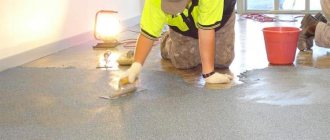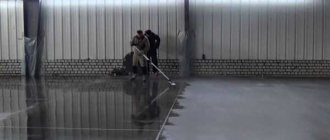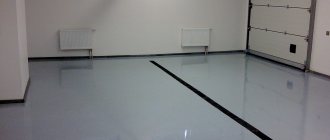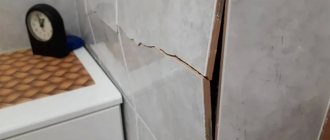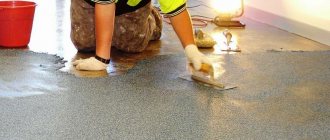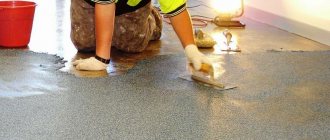SHARE ON SOCIAL NETWORKS
FacebookTwitterOkGoogle+PinterestVk
A high-quality concrete floor is a strong, reliable and durable foundation. However, such a surface is not without drawbacks. The main one is the formation of large amounts of dust during operation, which negatively affects human health and the operation of equipment and mechanisms. Dust removal from the concrete floor will help eliminate this problem; methods for doing this can be found in this article.
During the operation of a concrete base, a large amount of dust appears; the problem is solved by removing dust from the floor with special impregnations.
Reasons for the formation of concrete dust
The cause of dust on the surface of a concrete floor is associated with erosion of its top layer. The structural structure of hardened concrete is represented by a pronounced conglomerate mixture, which contains dissimilar components. They differ not only in size, but also in chemical composition. The process of maturation of cement stone involves the formation of a silicate crystal lattice. It intersects with coarse-grained insoluble fillers of gravel and sand origin.
Erosion of the top layer of a concrete floor leads to dust on its surface
Concrete consists of many microscopic and large pores that are filled with air, water and a gel cement substance. There are also unbound chemically active substances present here, which cause erosion processes in the upper layers of concrete. This occurs with constant mechanical impact on the concrete surface, the top porous layer of which begins to collapse. Unbound particles of cement and chemically active substances turn into dust.
In addition, during the ripening process of concrete, cement laitance comes to the surface. When it hardens, it forms a weakened layer, which is often the main source of dust.
To prevent a concrete floor from becoming dusty, it is necessary to harden it, bind the top layer with a polymer mesh, crystalline components, or completely remove the upper unstable surface. To do this, there are three methods for removing dust from the surface. This includes strengthening the base using topping, treating the coating with special impregnations and sanding the floor.
Important! The best result is obtained by the comprehensive use of all technologies for dust removal of concrete surfaces.
To remove dust from a concrete floor, you can use grinding, hardening with topping, and treatment with special impregnations.
Video description
The video shows how to paint a concrete floor with epoxy paint correctly:
Polyurethane
These are also two-component formulations that can be used both outdoors and indoors. A distinctive feature is the application technology. It consists of two stages:
- the first layer is a primer, which is applied to the floors so that there are no smudges; its drying time is 24 hours;
- the second layer is the main one, it is this layer that gives the concrete base the characteristics indicated by the manufacturer.
Attention! Polyurethane paint takes a long time to dry. After two days it stops sticking to shoes. After seven days, the film gains its declared strength. And after 14 days it calmly resists chemically active materials.
Advantages:
- high strength and wear resistance;
- resists chemicals well;
- economical in terms of material consumption;
- high hiding power;
- glossy surface.
Painting a concrete floor with polyurethane paint is easy. But for this, the foundation must first be prepared. This is a standard procedure for concrete floors - grinding and removing grinding products. If there are defects on the floor surface, they must be repaired.
After such preparation, the finished paint is poured from a bucket directly onto the floor and spread over it with a squeegee or spatulas. After which the final leveling is carried out using paint rollers. The most important thing in this process is to spread the paint in a thin layer.
Why is concrete floor dust removal done?
Dust removal is the strengthening of a concrete coating using toppings, impregnations or grinding, which is carried out to extend the period of its reliable operation.
If surface erosion processes are not stopped in time, they will eventually affect deeper layers of concrete. This can lead not only to partial, but also to complete destruction of the screed.
Cement dust that forms on the surface has a negative impact on human health. Tiny particles of cement and chemicals get into the eyes and skin, causing itching. Inhalation of substances can provoke respiratory diseases and cause allergic reactions.
When the concrete floor installed in workshops, garages, and warehouses becomes dusty, the dust has a negative impact on the coordinated operation of the equipment and mechanisms installed there. This will lead to rapid wear of tools and units, which will soon fail. A crumbling concrete floor needs constant cleaning - otherwise it will have a sloppy and untidy appearance.
Dust removal of a concrete coating not only extends its service life, but also improves its aesthetic appearance
If a concrete floor is used as a subfloor, even in this case the surface should be dust-free. If this is not done, over time the coating will begin to crunch and creak, which will cause inconvenience when using the surface.
How to cover a concrete floor to prevent it from collecting dust in a garage or other room
The destruction of the upper unstable layer of concrete leads to the constant formation of dust on the base. You cannot get rid of it instantly by sweeping it off the surface, since the next layer begins to collapse. It is best to eliminate this problem at the stage of curing the concrete screed, which is fixed with special compounds for removing dust from the concrete floor, which strengthen the surface and prevent its destruction throughout the entire period of operation.
Toppings and impregnations are used to prevent concrete from becoming dusty and to increase its strength. Such hardeners penetrate deeply into the pores of concrete, clogging them, blocking the paths for the formation and removal of dust. Such sealing eliminates not only the process of leaching of concrete, but also the destruction of its thickness as a result of exposure to moisture and chemicals that can penetrate it.
Dust-free floors are characterized by increased strength, durability, wear resistance, moisture resistance, and the ability to withstand any loads and intense impacts. Concrete bases with a hardened coating have an aesthetic appearance, which is achieved thanks to a smooth, even surface, tinted if necessary.
Toppings and impregnations will help you get rid of concrete dust in your garage forever
Briefly about the main thing
Quite universal ways to treat a concrete floor in a garage to avoid dust are paints, impregnations and fluates. There are other methods: ironing, priming, applying bitumen mastics, glue mixed with cement.
Today, consumers increasingly give their preference to paints. This is not only protection from dust, but also a decorative appearance of the concrete floor. Accordingly, its long-term operation.
The market today offers four main types of concrete paints: acrylic, polyurethane, epoxy and urethane-alkyd. Some of them are single-component, others are two-component.
All types of dust removal products are applied using conventional construction tools: brushes, rollers, spatulas, scrapers, squeegees or spray guns.
How to coat a concrete screed to avoid dust: features of topping compositions
When deciding how to cover a concrete floor to avoid dust, you should pay attention to innovative technology in the form of topping. This protective mixture consists of Portland cement, mineral additives, plasticizers and dyes. The first component serves to bind all the elements of the mixture, which contributes to the effective filling of concrete pores and adhesion to the coating, eliminating peeling of the material.
Topping provides increased strength and wear resistance of the concrete floor. This protective composition prevents the penetration of moisture into the thickness of concrete, which can cause destruction of its structure with subsequent leaching of the surface. A floor with a topping coating withstands the effects of chemical components, so it can be safely used in garages, production halls and workshops.
The composition penetrates deeply into the pores of concrete, clogging them, as a result of which the service life of the coating is extended, which is not destroyed by mechanical loads and other negative influences. Such a means for removing dust from a concrete floor has an acceptable cost, which makes it possible to inexpensively harden the coating. The cost of the process can be reduced to a greater extent by using low grades of cement to create the floor, the shortcomings of which can be compensated for by a heavy-duty protective composition.
The topping is available in the form of a dry powder or liquid composition. The powder is evenly scattered onto the surface, then compacted and sanded. When using dry substances on a concrete floor, seams are formed. This is a budget topping option. The liquid composition is evenly applied to the surface, forming a durable and reliable protective film that is resistant to moisture and chemical compounds. It turns out homogeneous, even and smooth.
The topping can be either in the form of a dry powder or a liquid composition.
Types of topping coating for concrete floors against dust
Modern topping is represented by three compositions: quartz, corundum and metallized. For rooms with average intensity of use, a composition based on quartz sand is used. This mixture not only provides dust removal and strengthening of the concrete surface, but also gives it an attractive appearance due to the presence of coloring pigments in its composition.
Quartz topping is suitable for arranging flooring in residential buildings, educational institutions, and warehouses. Another advantage of this option is the reasonable cost of the composition.
How to treat concrete to prevent dust in rooms where heavy equipment is located and where there is heavy traffic and people traffic? In these cases, it is better to use corundum topping, which includes a mineral additive in the form of corundum chips. This coating is characterized by high strength, wear resistance, resistance to abrasion, moisture and aggressive chemical compounds.
The most reliable hardener is metallized topping, which is made on the basis of metal shavings. It provides effective dust removal of the floor, which will maintain the integrity of the structure for many years. In addition, this topping increases the strength of the concrete surface by 2.5 times.
The liquid topping mixture can be applied both to a fresh concrete screed and to an old floor
It is advisable to use such a composition in rooms with high vibration, where massive, heavy equipment is installed, which requires constant movement of heavy equipment. The disadvantage of metallized topping is the high cost of the composition.
How to remove dust from a concrete floor: arranging a topping coating
How to treat a concrete floor to prevent dust in a garage, workshop, industrial, warehouse, public or residential area? The most correct solution is to arrange a topping coating. The composition can be presented in dry or liquid form, which determines the technology of its application.
The liquid mixture is applied to a fresh concrete screed or to an old floor. First of all, prepare the surface. It should be cleaned, all existing defects should be repaired and sanded. The topping is applied to the floor using a sprayer or roller. The layer thickness is 2-3 mm. The mixture is quickly absorbed and hardens.
The dry composition is evenly distributed over the entire surface area 5-6 hours after pouring the concrete screed. The process is carried out using a dosing trolley. Immediately apply 2/3 of the total volume of material. The composition begins to interact with moisture. This is how the crystallization process occurs. The completion of the reaction is indicated by complete and uniform darkening of the entire surface. It's time to sand the base with a sander. When rubbing the mixture is finished, you should wait until the surface sets.
The topping on the market is represented by three compositions: corundum, quartz and metallized
Important! To obtain a high-quality base, it is important to saturate the topping with cement laitance as much as possible without drying out the surface, while additionally moistening it with water is strictly prohibited.
The next step in treating the concrete floor from dust is applying the remaining amount of material. After 48 hours, the surface is cleaned using blade knives. The procedure is performed in several stages until a smooth, mirror-like base is achieved.
The final process is the application of a solution in the form of curing, which will eliminate the possibility of moisture evaporation from the concrete. The material is distributed over the surface using a roller or sprayer. Upon completion of the process, expansion joints are cut to prevent cracking of the concrete floor when the base hardens. The seams are filled with sealant. The cost of dust removal from concrete using topping starts from 1000 rubles/m².
Topping
The compositions are strengthening solutions based on cement and various additives. The required modification is selected depending on the category of the room and the operational loads placed on the floor. Wetting materials are used to increase the strength of the upper layers of concrete, providing them with reliable protection from abrasion, aggressive and mechanical damage.
After surface treatment, an insulating film with anti-slip and moisture-repellent properties is formed on the concrete floor.
The topping is suitable for treating heavily trafficked floors. At the same time, the technology is simple and accessible. For the most correct effect, the composition is laid on still uncured concrete with a thickness of more than 1 cm. The top layer is applied in several passes, followed by smoothing and grouting with special tools.
How to treat a concrete floor so that it does not generate dust: characteristics of special impregnations
To do it yourself to remove dust from a concrete floor, you can use special liquid impregnations on an organic or inorganic basis. They penetrate deeply into the thickness of concrete, forming a strong and reliable connection. Organic impregnations are presented in several varieties, namely in the form of epoxy, polyurethane, acrylic composition.
Polyurethane impregnation helps both dust removal of the floor and its complete sealing
The polyurethane mixture not only helps to remove dust from the floor, but also completely seals the base, which entails an increase in the strength, wear-resistant, impact-resistant and chemical-resistant characteristics of the surface. If it is used to remove dust from concrete M350 (or more), the required penetration depth of the impregnation is 2-3 mm, and for compositions M150-M350 this value increases to 5 mm.
Important! The polyurethane mixture has a strong, unpleasant odor, so it is recommended for use as an impregnation for outdoor concrete.
The epoxy mixture is produced completely odorless. It is represented by a two-component composition, the basis of which is epoxy resins. This impregnation ensures the creation of a strong, reliable, moisture-resistant, frost-resistant, durable base that is highly hygienic. The disadvantages of this mixture include its high cost.
Acrylic impregnation is preferable for surfaces that do not tolerate strong mechanical loads. It is used for concrete grade M200 (and more). Such a dust-free and strengthened base will be characterized by increased moisture resistance and high hygiene.
Acrylic impregnation is used to treat surfaces that are not subject to strong mechanical stress.
Inorganic mixtures are represented by fluates, which include sodium, potassium and lithium polysilicate compounds. The impregnation penetrates deeply into the porous structure of concrete, causing chemical reactions in its upper layer that last up to 15 days. This leads to the formation of insoluble, crystalline glassy bonds that clog the pores, hardening and removing dust from the surface.
Important! Any impregnation may contain a coloring pigment, which gives the finished coating a more attractive appearance.
How to choose paint for concrete
It is impossible to say that any of the paints described above are universal. Therefore, they must be chosen taking into account the purpose of the room. For example, acrylic compositions can be used in residential premises, since today concrete floors are in demand in private homes more than ever. This material is presented in a wide color palette. In addition, it is an excellent protective barrier against the appearance of concrete dust. The same cannot be said about polyurethane and epoxy compounds.
Be sure to pay attention to the temperature range in which this material should be used. That is, if this is a product for indoor use, then it should not be used outdoors. And the usual – “maybe it will blow by” – will not work here. At the very beginning, the concrete platform will look decent, but this will not last long.
If you decide to paint concrete floors in wet areas, be sure to look for a material that contains antibacterial additives. This is a guarantee that colonies of microorganisms will not appear on the floor during operation.
As for the texture. A matte surface is better, on which scratches and stains are less noticeable. Of course, gloss is more attractive, but it requires careful handling and constant maintenance. In any case, it will not be appropriate in the garage.
Painted concrete floor in a house Source blogspot.com
Surface dust removal technology using impregnation
Before applying impregnation to concrete, the floor must be treated with a grinding machine. This is done to remove the top destroyed layer, cement laitance, traces of dirt and oils, while simultaneously leveling the surface.
Related article:
Liquid glass for waterproofing: reliable protection against moisture
Water-repellent characteristics of the material. Application of the product on various objects. Work procedure and rules for preparing the solution
Sanding can be done on a damp or dry base. The latter option is characterized by high productivity and the ability to control the process. The wet sanding method produces a well-polished surface.
Before treating a concrete floor with impregnation, it must be sanded
Important! Treating the floor with a grinding machine helps open the pores of the concrete base, which improves the efficiency of penetration of the composition into the thickness of the surface and forms persistent chemical compounds.
Any impregnation is applied using a fluffy roller, brush or spray. The composition is poured onto the prepared base in strips. It is necessary to ensure uniform filling of the entire surface area. There should be no places where the composition is quickly absorbed into the concrete, or areas with minimal saturation where puddles have formed. The inorganic composition is applied in one layer.
The base must be coated twice with polymer impregnations. The composition is evenly distributed over the surface using a squeegee or silicone roller. After 30-50 minutes, a second layer of the mixture is applied. The surface must dry for 20 minutes. After time, all excess impregnation should be removed with a rag.
After 24 hours, the hardened and dust-free surface can be painted with polyurethane-based enamel, which is applied in two layers. After 24 hours, the surface is suitable for use. The price for dust removal of a concrete floor using impregnations starts from 800 rubles/m².
Concrete floors must be treated with polymer impregnations twice
Important! The surface dust-free by impregnation is characterized by several times increased strength, which depends on the quality of the original concrete base.
How to remove concrete dust: method of grinding and polishing the surface
When deciding what to do to prevent the concrete floor from collecting dust, you can use another technology, which is surface grinding. It can not only precede further surface treatment using toppings and impregnations, as mentioned above, but also be the final stage for preparing the surface for use.
Sanding can be done dry or on a damp surface. The first method is in great demand. The grinding process can be controlled visually. In this case, there is no need to wait for the surface to dry. The main disadvantage of this method is the formation of a large amount of dust during work.
Helpful advice! To facilitate the dry grinding process, it is recommended to connect a washing vacuum cleaner to the grinding equipment.
You can dust off a concrete floor using a grinder on both the old and freshly laid base.
Concrete dust removal using a grinding machine can be carried out on a moistened base, which is used mainly when arranging mosaic floors with granite or marble coating. The surface is perfectly flat, smooth, close to polished. However, the process is characterized by high labor intensity and low productivity, which is associated with the rapid clogging of abrasive elements with wet sludge, which are difficult to remove in a timely manner.
How to remove construction dust from a concrete floor using a sander
Grinding is carried out with a mosaic grinding machine, which is a heavy-duty unit equipped with an electric drive. The working part is equipped with one or more rotating disks with corundum or diamond segments, which differ in grain size.
Helpful advice! To sand a small area, they often use a special attachment for an angle grinder.
You can dust off a concrete floor using a grinder on the old base or on a freshly laid screed. In the latter case, the first stage of the process begins a week after pouring the floor, which will allow the resulting layer of cement laitance to be removed, exposing more durable layers. Finishing work is carried out after the concrete has completely set, which occurs after 28 days.
Grinding of a concrete floor occurs both on a moistened surface and in a dry way.
Surface grinding is carried out in several stages. First of all, it is necessary to remove the loose top layer, which is accompanied by exposure of the filler and preliminary leveling of the surface. On the old base, the grinder completely removes eroded areas of the concrete floor. This stage involves the use of segments with a grain size of 30-40 units.
Subsequently, the base is strengthened using special impregnations. This type of work may not be performed if the topcoat is sanded. The final stage is surface treatment with abrasive segments with a grain size of 100-400 units. to obtain a smooth, even, dust-free floor.
In case of urgent need, the floor surface is polished using diamond segments with a grain size of 1500-3000 units, which allows you to obtain a mirror-like, moisture-resistant, dust-free base.
To process the old base with a grinder, segments with a grain size of 30-40 units are used.
